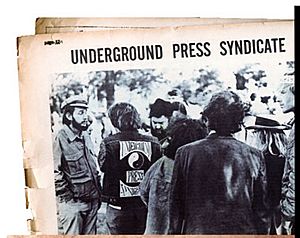Underground Press Syndicate facts for kids
| Syndication | |
| Fate | Defunct |
| Successor | Alternative Press Syndicate (APS) |
| Founded | 1966 |
| Founders | Walter Bowart, John Wilcock, Art Kunkin, Max Scherr, Michael Kindman, and Harvey Ovshinsky |
| Defunct | c. 1978 |
|
Area served
|
United States, Canada & Europe |
|
Key people
|
Tom Forcade |
The Underground Press Syndicate (UPS) was a special network of newspapers and magazines. It was started in 1966 by publishers of five early "underground" papers. These papers were the East Village Other, the Los Angeles Free Press, the Berkeley Barb, The Paper, and Fifth Estate.
The UPS helped these unique newspapers share their stories and ideas. Later, it was also known as the Alternative Press Syndicate (APS). For many years, Tom Forcade led the Underground Press Syndicate. He later started High Times magazine.
In November 1966, there were 14 papers in the UPS. But in just a few years, this number grew a lot! By 1971, there were 271 UPS-linked papers across the United States, Canada, and Europe. Historian John McMillian said that millions of people read these underground papers.
How the Underground Press Syndicate Worked
The members of the UPS had a cool agreement. They allowed all other members to freely print their articles, cartoons, and news. They also sent each other free copies of their newspapers. Plus, they would sometimes print a list of all UPS newspapers and their addresses. Anyone who agreed to these rules could join the syndicate.
This meant that news, opinions, and funny cartoons from the counterculture movement could be shared widely. Even small, new papers could get lots of content easily. For example, a report from Fifth Estate about the 1967 Detroit riots was copied by many other papers. The idea was also to sell national ads for all papers, but this never fully happened.
The early papers were very different in how they looked and what they wrote about. Some were very serious about politics. Others, like the San Francisco Oracle, focused on spiritual topics and had amazing designs. The Rag in Austin was known for mixing counterculture ideas with politics. It showed how the "New Left" movement was trying to combine politics and culture.
The Story of UPS: Growth and Change
After the UPS started, many more "underground" papers began to appear across North America. Walter Bowart and John Wilcock from the East Village Other, along with Michael Kindman from The Paper, helped invite other papers to join.
Soon, papers like The San Francisco Oracle, The Rag, and the Illustrated Paper joined. Membership quickly grew in 1967 as new papers were created and immediately became members. The Inquisition from Charlotte, North Carolina, was the first paper from the South to join.
The first meeting of underground papers happened in March 1967 in Stinson Beach, California. About 30 people from half a dozen papers attended. This meeting helped the papers feel more connected. It made them feel like they were part of a bigger national community.
By June 1967, a UPS meeting in Iowa City brought together 80 newspaper editors. They came from the US and Canada. Liberation News Service (LNS) was also there. LNS was another important group that helped the underground press grow.
Soon after, Tom Forcade took charge of the UPS. He opened an office in New York City. There, he collected underground papers for microfilming and published the UPS News Service. In 1972, the offices moved to Miami to cover political conventions. Under Forcade, UPS also published the Underground Press Revue.
The fast growth of underground papers slowed down by 1970. By 1973, the big boom was over. After a meeting in Boulder, Colorado, in 1973, the syndicate changed its name to the Alternative Press Syndicate (APS). The APS tried to keep the network going. They also tried to sell ads to help the papers make money. This effort was called APSmedia. It helped some papers get ads, especially from music and stereo companies. But APSmedia eventually closed in 1976.
By 1974, most underground newspapers in the U.S. had stopped publishing. However, their ideas and influence lived on. Many new, smaller papers in towns and suburbs were inspired by them. These papers offered different views on local news and culture. Some focused on specific topics like Native American politics or the environment.
The UPS and Women's Rights
As the underground press grew, the topic of women's rights became more important. At first, the underground press was mostly run by men. But at their 1969 conference, the UPS passed some important rules:
- They said that male chauvinism (unfair treatment of women) should be removed from their papers. For example, papers should stop using women's bodies in ads to sell products.
- They asked papers to publish more articles about women's challenges and their fight for freedom.
- They stated that women should have full roles in all parts of the newspaper staff.
These rules led to changes. In some papers, like Rat, women staff members took control for a few issues. Some papers, already facing money problems, closed down after these changes.


